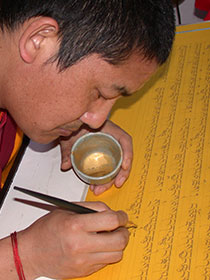- Home
- FPMT Homepage
Foundation for the Preservation of the Mahayana Tradition
The FPMT is an organization devoted to preserving and spreading Mahayana Buddhism worldwide by creating opportunities to listen, reflect, meditate, practice and actualize the unmistaken teachings of the Buddha and based on that experience spreading the Dharma to sentient beings. We provide integrated education through which people’s minds and hearts can be transformed into their highest potential for the benefit of others, inspired by an attitude of universal responsibility and service. We are committed to creating harmonious environments and helping all beings develop their full potential of infinite wisdom and compassion. Our organization is based on the Buddhist tradition of Lama Tsongkhapa of Tibet as taught to us by our founders Lama Thubten Yeshe and Lama Thubten Zopa Rinpoche.
- Willkommen
Die Stiftung zur Erhaltung der Mahayana Tradition (FPMT) ist eine Organisation, die sich weltweit für die Erhaltung und Verbreitung des Mahayana-Buddhismus einsetzt, indem sie Möglichkeiten schafft, den makellosen Lehren des Buddha zuzuhören, über sie zur reflektieren und zu meditieren und auf der Grundlage dieser Erfahrung das Dharma unter den Lebewesen zu verbreiten.
Wir bieten integrierte Schulungswege an, durch denen der Geist und das Herz der Menschen in ihr höchstes Potential verwandelt werden zum Wohl der anderen – inspiriert durch eine Haltung der universellen Verantwortung und dem Wunsch zu dienen. Wir haben uns verpflichtet, harmonische Umgebungen zu schaffen und allen Wesen zu helfen, ihr volles Potenzial unendlicher Weisheit und grenzenlosen Mitgefühls zu verwirklichen.
Unsere Organisation basiert auf der buddhistischen Tradition von Lama Tsongkhapa von Tibet, so wie sie uns von unseren Gründern Lama Thubten Yeshe und Lama Thubten Zopa Rinpoche gelehrt wird.
- Bienvenidos
La Fundación para la preservación de la tradición Mahayana (FPMT) es una organización que se dedica a preservar y difundir el budismo Mahayana en todo el mundo, creando oportunidades para escuchar, reflexionar, meditar, practicar y actualizar las enseñanzas inconfundibles de Buda y en base a esa experiencia difundir el Dharma a los seres.
Proporcionamos una educación integrada a través de la cual las mentes y los corazones de las personas se pueden transformar en su mayor potencial para el beneficio de los demás, inspirados por una actitud de responsabilidad y servicio universales. Estamos comprometidos a crear ambientes armoniosos y ayudar a todos los seres a desarrollar todo su potencial de infinita sabiduría y compasión.
Nuestra organización se basa en la tradición budista de Lama Tsongkhapa del Tíbet como nos lo enseñaron nuestros fundadores Lama Thubten Yeshe y Lama Zopa Rinpoche.
A continuación puede ver una lista de los centros y sus páginas web en su lengua preferida.
- Bienvenue
L’organisation de la FPMT a pour vocation la préservation et la diffusion du bouddhisme du mahayana dans le monde entier. Elle offre l’opportunité d’écouter, de réfléchir, de méditer, de pratiquer et de réaliser les enseignements excellents du Bouddha, pour ensuite transmettre le Dharma à tous les êtres. Nous proposons une formation intégrée grâce à laquelle le cœur et l’esprit de chacun peuvent accomplir leur potentiel le plus élevé pour le bien d’autrui, inspirés par le sens du service et une responsabilité universelle. Nous nous engageons à créer un environnement harmonieux et à aider tous les êtres à épanouir leur potentiel illimité de compassion et de sagesse. Notre organisation s’appuie sur la tradition guéloukpa de Lama Tsongkhapa du Tibet, telle qu’elle a été enseignée par nos fondateurs Lama Thoubtèn Yéshé et Lama Zopa Rinpoché.
Visitez le site de notre Editions Mahayana pour les traductions, conseils et nouvelles du Bureau international en français.
Voici une liste de centres et de leurs sites dans votre langue préférée
- Benvenuto
L’FPMT è un organizzazione il cui scopo è preservare e diffondere il Buddhismo Mahayana nel mondo, creando occasioni di ascolto, riflessione, meditazione e pratica dei perfetti insegnamenti del Buddha, al fine di attualizzare e diffondere il Dharma fra tutti gli esseri senzienti.
Offriamo un’educazione integrata, che può trasformare la mente e i cuori delle persone nel loro massimo potenziale, per il beneficio di tutti gli esseri, ispirati da un’attitudine di responsabilità universale e di servizio.
Il nostro obiettivo è quello di creare contesti armoniosi e aiutare tutti gli esseri a sviluppare in modo completo le proprie potenzialità di infinita saggezza e compassione.
La nostra organizzazione si basa sulla tradizione buddhista di Lama Tsongkhapa del Tibet, così come ci è stata insegnata dai nostri fondatori Lama Thubten Yeshe e Lama Zopa Rinpoche.
Di seguito potete trovare un elenco dei centri e dei loro siti nella lingua da voi prescelta.
- 欢迎 / 歡迎
简体中文
“护持大乘法脉基金会”( 英文简称:FPMT。全名:Foundation for the Preservation of the Mahayana Tradition) 是一个致力于护持和弘扬大乘佛法的国际佛教组织。我们提供听闻,思维,禅修,修行和实证佛陀无误教法的机会,以便让一切众生都能够享受佛法的指引和滋润。
我们全力创造和谐融洽的环境, 为人们提供解行并重的完整佛法教育,以便启发内在的环宇悲心及责任心,并开发内心所蕴藏的巨大潜能 — 无限的智慧与悲心 — 以便利益和服务一切有情。
FPMT的创办人是图腾耶喜喇嘛和喇嘛梭巴仁波切。我们所修习的是由两位上师所教导的,西藏喀巴大师的佛法传承。
繁體中文
護持大乘法脈基金會”( 英文簡稱:FPMT。全名:Found
ation for the Preservation of the Mahayana Tradition ) 是一個致力於護持和弘揚大乘佛法的國際佛教組織。我們提供聽聞, 思維,禪修,修行和實證佛陀無誤教法的機會,以便讓一切眾生都能 夠享受佛法的指引和滋潤。 我們全力創造和諧融洽的環境,
為人們提供解行並重的完整佛法教育,以便啟發內在的環宇悲心及責 任心,並開發內心所蘊藏的巨大潛能 — 無限的智慧與悲心 – – 以便利益和服務一切有情。 FPMT的創辦人是圖騰耶喜喇嘛和喇嘛梭巴仁波切。
我們所修習的是由兩位上師所教導的,西藏喀巴大師的佛法傳承。 察看道场信息:
- FPMT Homepage
- News/Media
-
- Study & Practice
-
-
- About FPMT Education Services
- Latest News
- Programs
- New to Buddhism?
- Buddhist Mind Science: Activating Your Potential
- Heart Advice for Death and Dying
- Discovering Buddhism
- Living in the Path
- Exploring Buddhism
- FPMT Basic Program
- FPMT Masters Program
- FPMT In-Depth Meditation Training
- Maitripa College
- Lotsawa Rinchen Zangpo Translator Program
- Universal Education for Compassion & Wisdom
- Online Learning Center
-
- Prayers & Practice Materials
- Overview of Prayers & Practices
- Full Catalogue of Prayers & Practice Materials
- Explore Popular Topics
- Benefiting Animals
- Chenrezig Resources
- Death & Dying Resources
- Lama Chopa (Guru Puja)
- Lama Zopa Rinpoche: Compendium of Precious Instructions
- Lama Zopa Rinpoche: Life Practice Advice
- Lama Zopa Rinpoche Practice Series
- Lamrim Resources
- Mantras
- Prayer Book Updates
- Purification Practices
- Sutras
- Thought Transformation (Lojong)
- Audio Materials
- Dharma Dates - Tibetan Calendar
- Translation Services
- Publishing Services
- Ways to Offer Support
- Prayers & Practice Materials
-
- Teachings and Advice
- Find Teachings and Advice
- Lama Zopa Rinpoche Advice Page
- Lama Zopa Rinpoche: Compendium of Precious Instructions
- Lama Zopa Rinpoche Video Teachings
- ༧སྐྱབས་རྗེ་བཟོད་པ་རིན་པོ་ཆེ་མཆོག་ནས་སྩལ་བའི་བཀའ་སློབ་བརྙན་འཕྲིན།
- Podcasts
- Lama Yeshe Wisdom Archive
- Buddhism FAQ
- Dharma for Young People
- Resources on Holy Objects
- Teachings and Advice
-
-
*If a menu item has a submenu clicking once will expand the menu clicking twice will open the page.
-
-
- Centers
-
- Teachers
-
- Projects
-
-
-
-
*If a menu item has a submenu clicking once will expand the menu clicking twice will open the page.
-
-
- FPMT
-
-
-
-
-
One of the hallmarks of Buddhism is that you can’t say that everybody should do this, everybody should be like that; it depends on the individual.
Lama Thubten Yeshe
-
-
-
- Shop
-
-
-
The Foundation Store is FPMT’s online shop and features a vast selection of Buddhist study and practice materials written or recommended by our lineage gurus. These items include homestudy programs, prayers and practices in PDF or eBook format, materials for children, and other resources to support practitioners.
Items displayed in the shop are made available for Dharma practice and educational purposes, and never for the purpose of profiting from their sale. Please read FPMT Foundation Store Policy Regarding Dharma Items for more information.
-
-
Mandala
11
Mandala Online: How Does Mindfulness Relate to Middle Way Philosophy?
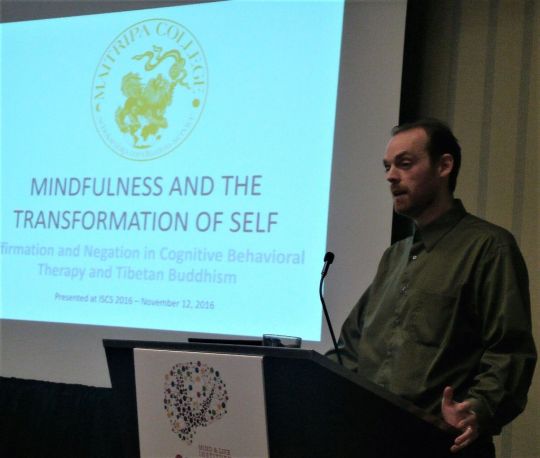
Jacob Sky Lindsley presenting his research at the November 2016 conference of the Mind and Life Institute, San Diego, California, USA. Photo by Doug Huppe.
We hear about mindfulness everywhere, it seems. Many of us practice it. But what is it doing? And how does it relate to Buddhist teachings on the emptiness of the self? If both mindfulness and Madhyamaka are methods to transform our experience of the self and reduce suffering, how do they differ in their approach?
Mandala recently interviewed Jacob Sky Lindsley, a graduate of FPMT-affiliated Maitripa College who will soon start Ph.D. studies in psychology. The conversation centered on the relationship between highly popular mindfulness therapies and Madhyamaka (Middle Way) philosophy as propounded by Lama Tsongkhapa and many other scholars—the topic of Jacob’s master’s thesis and the subject of a paper he presented at the November 2016 International Symposium of Contemplative Studies of the Mind and Life Institute, the organization associated with His Holiness the Dalai Lama that explores science and Buddhism.
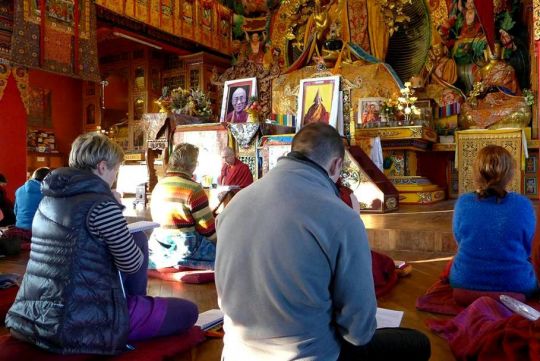
Dharma students meditating at Kopan Monastery, Nepal, December 2016. Photo by Laura Miller.
Explains Jacob, “[Mindfulness] does help people. But it is far less radical than realizing the emptiness of the self … It just moves the attribution of self from the story, the narrative self, to another part of the self, the flow of experience or the awareness. But it still ascribes ‘self’ or ‘I’ to those things … Instead of saying ‘I am my story,’ we say ‘I am these sensations’ or ‘I am this awareness of the passing flow.’ But the mistake, the hallucination of ‘I,’ is still 100 percent there.”
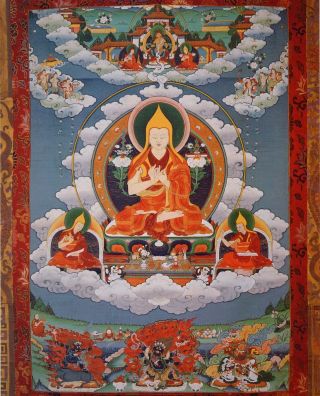
Lama Tsongkhapa. Photo courtesy of FPMT Charitable Projects.
He adds, “The Gelug method [of analyzing and meditating on the emptiness of the self] seems to be able to eliminate our distorted conception of the self, not just help people create a more adaptive sense of self.”
And although Jacob respects what mindfulness therapies can do by helping people move away from identifying with their sometimes unhealthy internal narratives, he also points out that “an over-focus on mindfulness to improve well-being obscures this traditional Buddhist method for confronting our habitual relationship to self and leaves untouched its potential for ending suffering.”
He concludes that “there are reasons to consider expanding the study of meditation-based therapies, and their effects, to include the Buddhist understanding of self … After all, if attributing ‘self’ to ever-evolving experience creates suffering, doing less of it should reduce suffering. That would have to be tested, so pulling these meditations into social science research makes sense … Mindfulness came from Buddhism, after all, and is now widely used in secular therapeutic contexts. Stopping believing in a hallucinated self may also be profoundly therapeutic.”
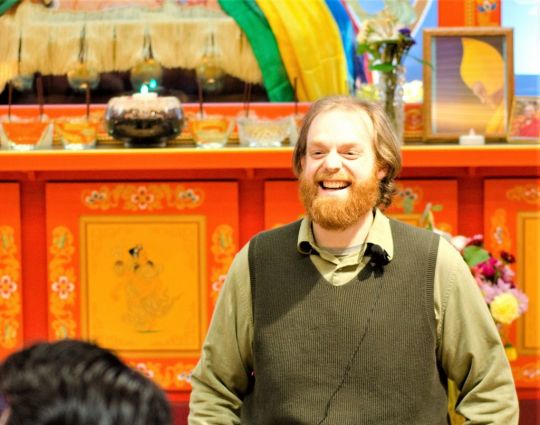
Jacob Sky Lindsley teaching meditation as part of the public program at Maitripa College, March 2016. Photo by Marc Sakamoto.
Read “New Self / No Self: Jacob Sky Lindsley on Mindfulness and Madhyamaka,” Mandala‘s newest online feature:
https://fpmt.org/mandala/in-depth-stories/new-self-no-self-jacob-sky-lindsley-on-mindfulness-and-madhyamaka/
Mandala is offered as a benefit to supporters of the Friends of FPMT program, which provides funding for the educational, charitable, and online work of FPMT.
- Tagged: emptiness, interview, jacob sky lindsley, madhyamaka, mindfulness
19
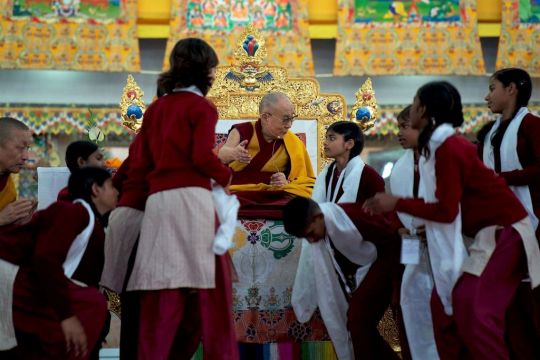
His Holiness talks with students from Maitreya School after their recitation, Bodhgaya, India, January 2017. Photo by Bill Kane.
Mandala has just published “His Holiness the Dalai Lama Gives His 34th Kalachakra Initiation,” an online feature—with plenty of great photos—about the Kalachakra initiation held recently in Bodhgaya, India, and FPMT’s involvement in it. This was the 34th such initiation His Holiness has granted and the fifth one in Bodhgaya, and more than 220,000 people attended, including students from FPMT centers around the globe. FPMT’s Root Institute for Wisdom Culture, set amidst beautiful grounds overflowing with statues and stupas, was filled with guests including Lama Zopa Rinpoche; Tenzin Ösel Hita; Yangsi Rinpoche; Cherok Lama; Tenzin Phuntsok Rinpoche; Tenzin Rigsel, the three-year-old reincarnation of the late Khen Rinpoche Lama Lhundrup; and other lamas and geshes, as well as many FPMT Sangha. Even actor Richard Gere was among the guests. A special team was put in place by Root Institute to coordinate FPMT’s involvement.

Kalachakra sand mandala, Bodhgaya, India, January 2017. Photo by Cynthia Karena
One particularly exciting moment for FPMT: students from FPMT’s Maitreya School in Bodhgaya were given the opportunity to recite the Heart Sutra in Sanskrit to His Holiness.
Ven. Tenzin Paldron, director of Root Institute, explained: “Dee Chandrashekhar, FPMT India’s national coordinator, had developed a tune for the Heart Sutra in Sanskrit and a couple of years ago Lama Zopa Rinpoche asked her to come and teach it to the Maitreya School children. She came last summer, and the children learned it. With their teacher they reviewed it on a regular basis, to the point where they felt confident. They were ready. Twelve girls and one boy sat in front of His Holiness and the whole audience and recited the Heart Sutra. They also offered a handmade placard with wishes for a happy 34th Kalachakra puja. It was historic; I don’t think children have recited the Heart Sutra in Sanskrit for His Holiness before. And they are very devoted when they recite—they do it with their full heart. His Holiness was deeply moved; he called it ‘wonderful’ and ‘inspiring.’ And he offered one hundred thousand rupees (US$1,500) to be used to take all 190 of the Maitreya School children on a picnic. The children were so happy!”
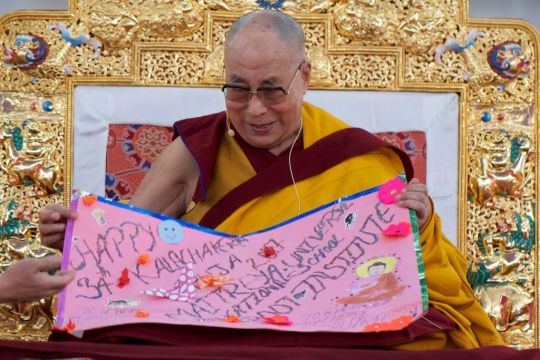
Hi Holiness examines the placard offering best wishes from the children of Maitreya School, Bodhgaya, India, January 2017. Photo by Bill Kane.
Read “His Holiness the Dalai Lama Gives His 34th Kalachakra Initiation,” Mandala‘s newest online feature:
https://fpmt.org/mandala/in-depth-stories/his-holiness-the-dalai-lama-gives-his-34th-kalachakra-initiation/
Mandala is offered as a benefit to supporters of the Friends of FPMT program, which provides funding for the educational, charitable, and online work of FPMT.
28
Dieter Kratzer on Becoming a Teacher
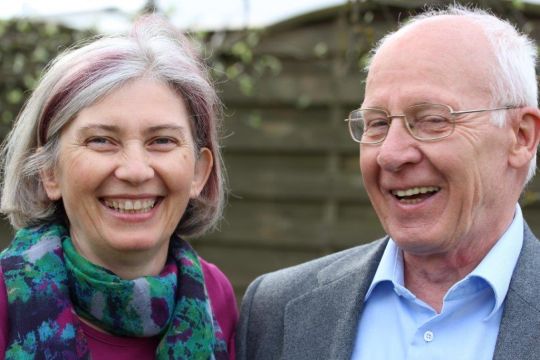
Dieter Kratzer with his wife Maria. Photo courtesy of Dieter Kratzer.
In an interview with Mandala now published online, FPMT registered in-depth teacher Dieter Kratzer, 75, talks about his life in the Dharma, and particularly the process of becoming a teacher.
Dieter met the Dharma in 1973 and was among the first Westerners to lead meditation courses at Kopan Monastery in Nepal. Dieter has now spent forty years teaching the Dharma: work he was requested to do by the Lamas and also finds closest to his heart. He is currently the resident teacher of Tara Mandala in Bavaria, Germany, an FPMT center he and his wife Maria established twenty years ago.
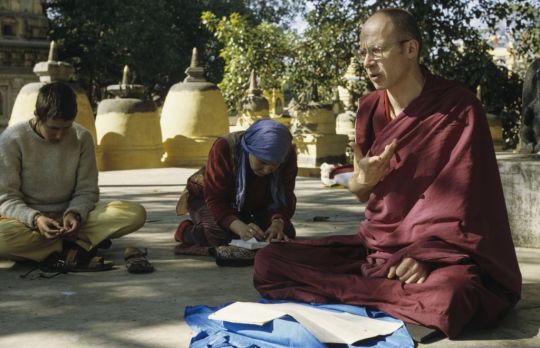
Dieter Kratzer teaching on vows at the request of Lama Yeshe, Main Stupa, Bodhgaya, India, 1982. Photo by Ina Van Delden, courtesy of Lama Yeshe Wisdom Archive.
“I believe that teachers have to be a living example of the teachings; the teacher can be the teaching,” says Dieter. “That means not just having experience of the Dharma, but also living one’s life in a way that inspires confidence and forms the basis of good relationships with others. I have a lot of help from my wife in this … Lama Yeshe said, ‘If there is energy, there is center. If no energy, no center.’ Keeping a center going is tough. It is important, as a teacher, to stay in one place, to be available to meet people’s needs. That’s different from traveling teachers. They don’t have this close relationship with students. Setting an example and having good relationships are both part of transmitting the Dharma. Lama Yeshe said once, ‘We want quality, not quantity.’ That stayed in my mind. For me it’s best to have small groups and work closely with people. So I teach small groups, ten to twenty-five people, a few times a week, year round, in a way that I get to know people and they know that they can rely on me.”
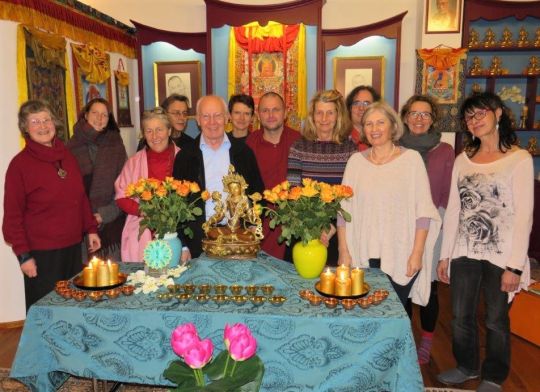
Dieter Kratzer with students at Tara Mandala, Germany. Photo courtesy of Dieter Kratzer.
Read more of Dieter’s reflections on becoming a teacher in “Dieter Kratzer on Becoming a Teacher,” Manadala‘s newest online feature:
https://fpmt.org/mandala/in-depth-stories/dieter-kratzer-on-becoming-a-teacher/
Mandala is offered as a benefit to supporters of the Friends of FPMT program, which provides funding for the educational, charitable and online work of FPMT.
- Tagged: dieter kratzer, fpmt history, fpmt-registered teachers, interview
- 0
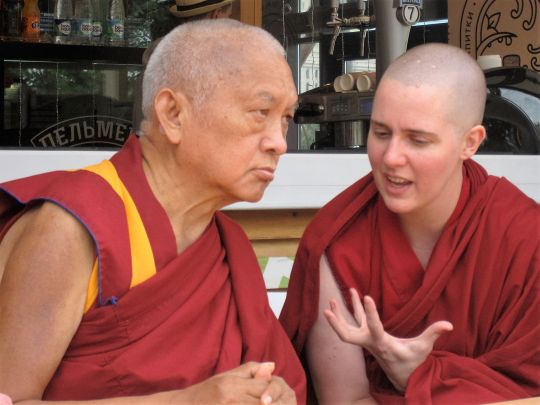
Lama Zopa Rinpoche with Ven. Yönten in Russia, 2015. Photo by Ven. Tenzin Chodron.
Was the Buddha a community worker?
In a reflection on life in community published online as part of the January-June 2017 issue of Mandala, Ven. Lozang Yönten says she was. Laughing about her everyday struggles with the afflicted minds that arise even in her good living conditions—among Dharma practitioners she describes as kind, patient, introspective, well-intentioned, caring, sincere, and supportive—Ven. Yönten reports that she relies on tales about the Buddha himself to get her through, especially those found in the monastic code, or vinaya.
“In it,” she explains, “are revealed practical strategies to improve harmony and everyday happiness on our way to enlightenment. Having difficulty with someone? Here are ideas about effective communication. Having trouble controlling your five senses? Here are some handy ways to keep yourself under control while you build inner strength. Whenever his unruly community got up to some new mischief, Buddha gathered them together and explained compassionately, with logic, why that behavior doesn’t help.”
Ven. Yönten also tries to emulate the Buddha’s way of helping others along the path: showing rather than telling, as in the story of Kisa Gotami and the mustard seed. “A mother’s child died and she, grief-stricken, went to the Buddha. He didn’t say, ‘You aren’t the only person who has ever lost someone, try to see the big picture.’ Not at all. He knew that logic would have no place to land in her mind and wouldn’t soothe her pain. Instead he told her to get a mustard seed from a household that had never experienced loss. Through her process of searching, unable to find a single one, she opened her heart and connected to her spiritual path. Buddha empowered her wisdom to arise and develop—he didn’t force-feed her something she wasn’t ready to hear.”
Read more of Ven. Yönten’s thoughts on working with challenges in “Buddha Was a Grassroots Organizer,” part of the Mandala‘s January-June 2017 online content.
Mandala is offered as a benefit to supporters of the Friends of FPMT program, which provides funding for the educational, charitable and online work of FPMT.
The new print issue of Mandala magazine is available through the FPMT Foundation Store.
- Tagged: sangha, ven. lozang yonten
- 0
2
Mandala Online: A Retreat Center Is Launched

Land of Joy Retreat Centre and garden. Photo by Fiona Oliver.
As part of Mandala‘s January-June 2017 online content, long-time FPMT student Andy Wistreich reports on the founding of Land of Joy Retreat Centre in the UK, enthusing, “Creating Land of Joy has been a life-transforming experience for the key people involved … We have discovered the meaning of our lives through our participation in the project.”
Land of Joy was a long time in the making: the decision to establish a rural retreat center in the UK was made in 2008. The group’s fundraising strategy relied on advice from Lama Zopa Rinpoche and emphasized merit-making. Said Andy, “This depended on a sincere faith that many of us didn’t really understand … Three times Rinpoche suggested practices, some to sponsor, and some for us to do ourselves, to generate success. Each time, we carried out Rinpoche’s advice to the smallest detail, and the more we did this, the stronger our faith became.” In time, the strategy bore fruit: funding fell into place almost miraculously, and in 2014, a property in Northumberland was identified and confirmed by Rinpoche. Prior to purchase, Andy reports, Rinpoche visited the site, known as Greenaugh Hall, blessed it, and recited the Vajra Cutter Sutra, showing great joy. The room where he had lunch is now the gompa, which Andy describes as having “a deep blessed energy.” The group is determined to continue their Dharma approach to money, and all retreats are being run on a “total generosity model.”
More information about Land of Joy and its upcoming retreats is available from landofjoy.co.uk.
Read more about the founding of Land of Joy in “Land of Joy: The Unforeseen Wonders of Founding a Retreat Center,” part of January-June 2017 issue’s online content.
Mandala is offered as a benefit to supporters of the Friends of FPMT program, which provides funding for the educational, charitable and online work of FPMT.
The new print issue of Mandala magazine is available through the FPMT Foundation Store.
- Tagged: land of joy
- 0
26

View of De-Tong Ling’s stupa and dam surrounded by pristine Australian bush. Photo by center director Will Abram.
“De-Tong Ling Retreat Centre,” says retreat manager Dani Guo proudly in “De-Tong Ling Retreat Centre: Down Under, a Meditator’s Paradise,” a Mandala January-June 2017 online content article, “is the kind of paradise sought after by serious meditators thirsting to actualize the teachings of the Buddha.” And a new chapter is now dawning for the Australian “place of bliss and emptiness”: the construction of a new group retreat center.
Thanks to a generous donation from an anonymous benefactor, construction of the new facility is now underway. Volunteers are needed to help, and the center welcomes willing hands: any takers?
The new facility will accommodate up to forty people and enable De-Tong Ling to hold group retreats of varying lengths. The center also expects to broaden its spiritual program to accommodate the diverse needs and interests of both local and international meditators. It is an exciting time. Dani points out, “On a mundane level, there appears to be a motley crew of people getting muddy and moving earth around a lot. But on a supramundane level, what is unfolding is the real life manifestation of Dharma—loving-kindness, community, dedication, devotion, purification, joyous effort, wisdom, selflessness, and unity.”
Venerable Thubten Dondrub, resident teacher at Buddha House in Adelaide, Australia, has noted that simply being at De-Tong Ling is a retreat in itself. The powerful effects of the blessed environment, offering a place for introspection and peace, are available to everyone who comes, whether for work or retreat.
De-Tong Ling runs two regular annual group retreats: a calm abiding retreat over Easter weekend and a ten-day lamrim retreat in October. Individual retreats are also encouraged. For more information, visit De-Tong Ling’s website.
Read more in “De-Tong Ling Retreat Centre: Down Under, a Meditator’s Paradise,” part of the online content for the January-June 2017 issue of Mandala.
Mandala is offered as a benefit to supporters of the Friends of FPMT program, which provides funding for the educational, charitable and online work of FPMT.
The new print issue of Mandala magazine is available through the FPMT Foundation Store.
- Tagged: de-tong ling, retreat
- 0
19
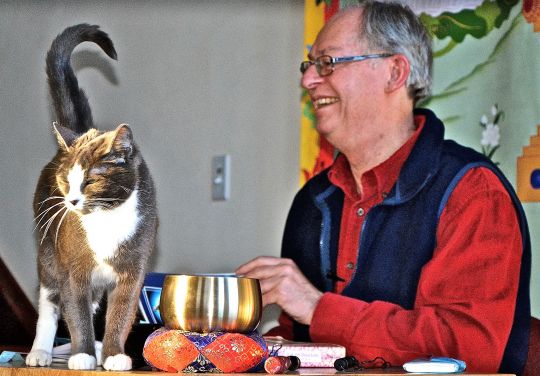
Dr. Roger Jackson gives Dharma teachings to Maitri the cat and others at Sravasti Abbey, Washington State, USA, February 2016. Photo courtesy of Sravasti Abbey.
Can university professors help to spread the Dharma? Professor and long-time Dharma teacher Roger Jackson thinks so, and takes the view that scholars of Buddhist studies have plenty to offer to Dharma centers. He discusses this and other issues concerning the teaching of both Dharma and Buddhist studies in a recent interview—“Teaching Buddhism, Spreading Dharma”—published online as part of the January-June 2017 issue of Mandala magazine.
“We shouldn’t think the Dharma can’t stand up to critical and historical analyses of the kind applied by academics,” says Roger, adding, “Most centers now understand that Buddhist academics won’t undermine the tradition; we are conversant with both traditional and academic approaches, and can discuss similarities and differences.” As a result, he indicates, many centers now invite university professors to teach, and the wall between “the academy” and Dharma centers is coming down.
Roger says that in Dharma centers he teaches texts “more or less as a geshe would” while laughingly declining to consider himself their equal. But he notes that Buddhist studies scholars can also enrich what is taught in centers by discussing historical, social, cultural, and philosophical issues from a modern perspective. That context can make it easier for Dharma students to apply Buddhism to modern life. For example, nowadays in universities, professors teach how Buddhism is actually lived in Buddhist cultures, looking at gender, power, social class, and so on—not just philosophy. These are issues today’s centers might also want to talk about. Says Roger, “We may want only ‘truth’, but [Michel] Foucault showed us that truth is embodied and related to power. We can’t escape that if we want to understand Buddhism. We can’t only study philosophy.”
Read more of Roger Jackson’s insights into teaching Dharma in “Teaching Buddhism, Spreading Dharma” as part of Mandala’s January-June 2017 online content.
Mandala is offered as a benefit to supporters of the Friends of FPMT program, which provides funding for the educational, charitable and online work of FPMT.
The new print issue of Mandala magazine is also available through the FPMT Foundation Store.
- Tagged: academia, roger jackson, scholars
- 0
12
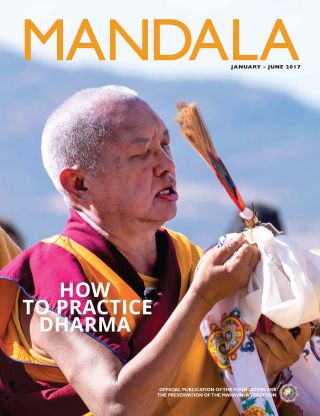
COVER: Lama Zopa Rinpoche during an Amitabha Buddha celebration at Buddha Amitabha Pure Land, Washington, US, October 2016. Photo by Chris Major.
Mandala magazine is in the mail! The exciting new issue is winging its way this very minute to supporters of the Friends of FPMT program as well as to students who receive it through the FPMT centers and projects that offer it as a benefit. As always, we at Mandala hope we have created a timeless publication that will inspire and strengthen the Dharma practice of readers.
In the latest issue, learn more about how to practice Dharma in the face of challenge and difficulty. Read what Lama Zopa Rinpoche has to say about understanding hardships; why Ven. Gyalten Lekden says hardships lie at the heart of practice; the thoughts of Khensur Denma Locho Rinpoche on the good fortune that comes from enduring hardships; and why Thubten Gyatso says Dharma is the perfect medicine. Savor as well the lessons Jean-Yves Barralis learned about dying while caring for Ven. Kunsang; how young Maddy Stafford found a home in Buddhism; and how Sarah Brooks was changed by her experiment in generosity. And don’t miss Dharma teachings from Ribur Rinpoche, Lama Yeshe, and Lama Zopa Rinpoche!
Mandala is also offering several online-only pieces, including:
- Teaching Buddhism, Spreading Dharma, an interview with longtime university professor and Dharma teacher Dr. Roger Jackson
- Land of Joy: The Unforeseen Wonders of Founding a Retreat Center
- De-Tong Ling Retreat Centre: Down Under, a Meditator’s Paradise
- Buddha Was a Grassroots Organizer
For this and more, see Mandala January-June 2017:
https://fpmt.org/mandala/archives/mandala-for-2017/january/

Lama Zopa Rinpoche at the Buddha Amitabha Festival, Washington State, USA, October 2016. Photo by Chris Majors.
Mandala is offered as a benefit to supporters of the Friends of FPMT program, which provides funding for the educational, charitable and online work of FPMT. The new issue is also available through the FPMT Foundation Store.
- Tagged: friends of fpmt, hardships, how to practice dharma, mandala
- 0
15
FDCW Brings Universal Education to the World
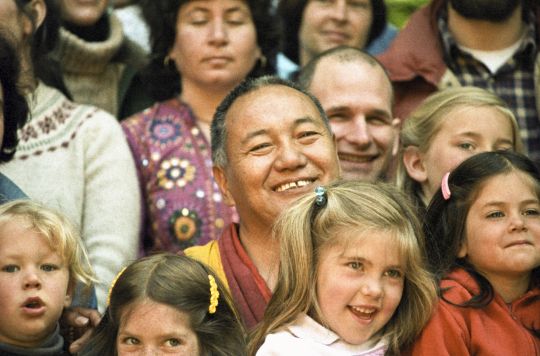
Lama Yeshe at a family gathering, Vajrapani Institute, California, US, 1983. Photo by Carol Royce-wilder, courtesy of Lama Yeshe Wisdom Archive.
The new issue of Mandala features the Foundation for Developing Compassion and Wisdom (FDCW), the UK-based FPMT international project that oversees the development and dissemination of Universal Education for Compassion and Wisdom (UECW) programs, such as the 16 Guidelines for Life and the new A.R.T. of Fulfillment program that is launching in 2017. UECW is the manifestation of FPMT founder Lama Yeshe’s vision of Universal Education, Buddhist-inspired learning for everyone. Under the guidance of Lama Zopa Rinpoche, FDCW is bringing these exciting and transformative programs to the world.
You can read Mandala‘s story “The Foundation for the Development of Compassion and Wisdom Carries Lama Yeshe’s Vision into the Future” as a PDF now available online to learn more about FDCW and UECW programs.
Mandala brings you news of Lama Zopa Rinpoche and of activities, teachings and events from nearly 160 FPMT centers, projects and services around the globe. If you like what you read on Mandala, consider becoming a Friend of FPMT, which supports our work.
9
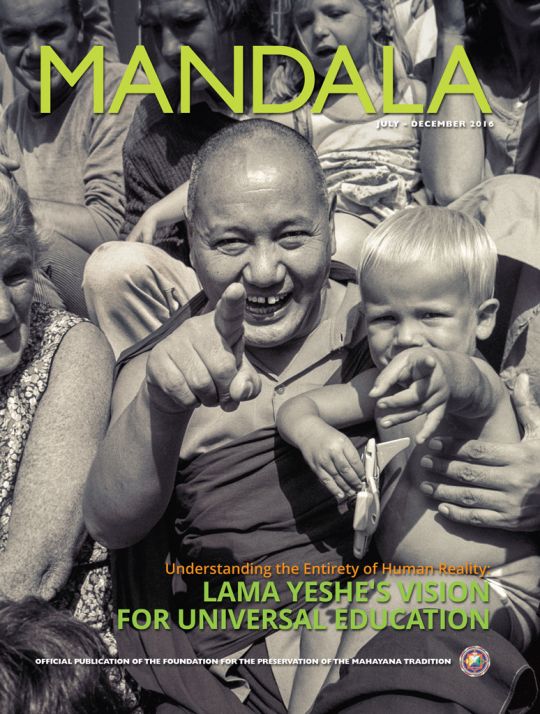
COVER: Lama Thubten Yeshe with child at Maitreya Instituut, the Netherlands, 1981. Photo by Ina van Delden. Digital enhancement by David Zinn. Photo courtesy of Lama Yeshe Wisdom Archive.
The latest issue of Mandala is in the mail to Friends of FPMT supporters and others who receive the magazine through their local FPMT center.
The new issue explores Universal Education, Lama Yeshe’s vision for transmitting the essence of Buddhadharma to people of every age and background. We also share teachings from His Holiness the Dalai Lama and Lama Zopa Rinpoche; interviews with Lama Yeshe, Robert Thurman and Jon Landaw; stories about Universal Education-related work being done at by Foundation for Developing Compassion and Wisdom, Istituto Lama Tzong Khapa and Maitripa College; and more!
It’s not too late to receive the new issue! Become a Friend of FPMT today or order an individual copy through the FPMT Foundation Store.
21
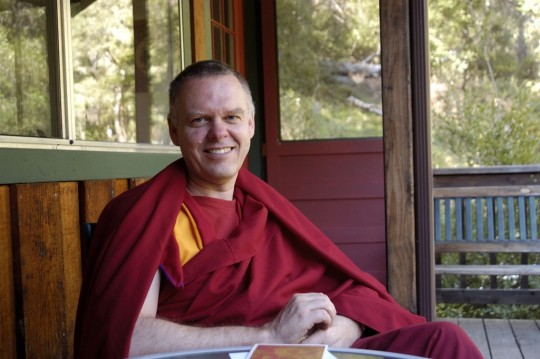
Ven. René Feusi, 2010
“In the 1990s, I went to Bodhgaya to do two months’ retreat. I had rented a cabin in Bodhgaya and one of the texts I had with me with was Bodhicharyavatara. It was Stephen Batchelor’s translation. While doing retreat there, they started to build a cabin just in front of mine. There were 20 or 30 Indians from early morning into late in the afternoon building and talking, and I started getting quite annoyed and angry. I was supposed to do retreat and was expecting quiet surroundings. I realized I could leave and try to find another place or try to make the best out the situation. And that’s when I remembered Shantideva’s chapter on patience,” FPMT registered teacher Ven. René Feusi shared in the January-June 2016 issue of Mandala while describing the evolution of his newest book, The Beautiful Way of Life, a distillation of Shantideva’s seminal work.
“I read it again and again, and liked it very much, but found that the way it was written was so flowery that I had difficulty following the stream of reasoning. So I said to myself, ‘Let’s attempt to write out what he actually says,’ taking away all the embellishments. What is his stream of ideas on how to remove anger? That’s how I started. It was enjoyable work. I discovered Shantideva’s text in a more intimate way. I worked on a few chapters there in Bodhgaya, and over the years, each time I would be in retreat, I would take it up again and do some more of the text.
“I went over it many, many times because new translations of Bodhicharyavatara would come out. I used at least five different translations to write The Beautiful Way of Life, each time seeing if there were some words that would be more appropriate from here or there. I lived at Vajrapani Institute in California for seven years and once showed the director, Fabienne Pradelle, what I had done and she said, ‘Oh, that’s great, you should finish it.’ Slowly, slowly over the years I finished it. She and another friend, Judith Kondo, went over the manuscript to polish up the English. We worked on it together. …”
Read the complete interview as a PDF.
First published in the January-June 2016 print issue of Mandala available through the FPMT Foundation Store or as a benefit of the Friends of FPMT program, you can now read the entire interview plus an excerpt from The Beautiful Way of Life as part of Mandala‘s January-June 2016 online content.
- Tagged: ven. rene feusi
- 0
9
By Ven. Chönyi Taylor
As part of the January-June 2016 online content, Mandala is happy to share the most recent Dharma Realities column by Ven. Chönyi Taylor, who has been contributing to Mandala‘s online edition since 2010.
What better way to describe the Christmas frenzy? Wish lust. The longer the list, the greater the lust. Or perhaps the more expensive the list, the greater the lust. Whatever. The point is that our Christmas wish list is mostly a list of lusts. The Christmas we celebrate is more like the Roman Saturnalia: a celebration marked by unrestrained licentiousness. Revelry. Saturnalia was an orgy, a celebration of lust. The winter solstice marked a return to lushness after the long winter nights.
The 1st-century poet Gaius Valerius Catullus described Saturnalia as “the best of times”: dress codes were relaxed; small gifts such as dolls, candles and caged birds were exchanged. The wealthy were expected to pay the month’s rent for those who couldn’t afford it; masters and slaves swapped clothes. Family households threw dice to determine who would become the temporary Saturnalian monarch. The god Cronos (Saturn) says:
During my week the serious is barred: no business allowed. Drinking and being drunk, noise and games of dice, appointing of kings and feasting of slaves, singing naked, clapping … an occasional ducking of corked faces in icy water – such are the functions over which I preside.1
Christians took over this solstice celebration and turned it into a renewal of life through the birth of Christ. Lust has no place in the new order. Instead, it is a celebration of the new commandment: that we love one another as Christ has loved us.
These two ways of celebrating the winter solstice pull us towards two different kinds of happiness. One is the riotous happiness of relief from temporary suffering. It is a happiness that is based on external things, on having our wants and lusts met, about having a comfortable life. The other is a quieter happiness that is based within, the happiness that comes from unconditional love.

Jesus Christ, from Lama Yeshe’s “Silent Mind, Holy Mind”
Love is, according to our Buddhist teaching, the desire for others to be happy. Compassion is the desire that they be released from suffering. The happiness that comes from these desires is an inward thing, a state of mind – and especially so because it arises from an inner state of mind rather than from external things.
Lama Yeshe’s teachings on Christmas are found in a precious book Silent Mind, Holy Mind, which is unfortunately out of print. A drawing of Jesus accompanies a daily practice by Lama Yeshe for people devoted to Jesus. “Jesus” said Lama Yeshe, “had exceptionally great compassion. It is very good to check up on this fact and consider it deeply. If the thought comes to the mind ‘I must gain his realizations and becomes as compassionate as he was’ then this is the most perfect basis on which to have a celebration of his birth. With this feeling in our hearts, a Christmas festival can be very meaningful and worthwhile.”
Ven. Chönyi Taylor is a registered Foundational Buddhism FPMT teacher and an elder for the Discovering Buddhism at Home Course. She is the author of Enough! A Buddhist Approach to Working with Addictive Patterns (Snow Lion, 2010) and has been published in Mandala, Buddhadharma, Dharma Vision and Sangha Magazine. She is a founding member and member of the training committee of the Australian Association of Buddhist Counsellors and Psychotherapists and an Honorary Lecturer in the Discipline of Psychiatry at Sydney University.
1. See more at http://www.historytoday.com/matt-salusbury/did-romans-invent-christmas#sthash.Fvu3F4TM.dpuf
- Tagged: christmas, ven. chonyi taylor
- 0
- Home
- News/Media
- Study & Practice
- About FPMT Education Services
- Latest News
- Programs
- New to Buddhism?
- Buddhist Mind Science: Activating Your Potential
- Heart Advice for Death and Dying
- Discovering Buddhism
- Living in the Path
- Exploring Buddhism
- FPMT Basic Program
- FPMT Masters Program
- FPMT In-Depth Meditation Training
- Maitripa College
- Lotsawa Rinchen Zangpo Translator Program
- Universal Education for Compassion & Wisdom
- Online Learning Center
- Prayers & Practice Materials
- Overview of Prayers & Practices
- Full Catalogue of Prayers & Practice Materials
- Explore Popular Topics
- Benefiting Animals
- Chenrezig Resources
- Death & Dying Resources
- Lama Chopa (Guru Puja)
- Lama Zopa Rinpoche: Compendium of Precious Instructions
- Lama Zopa Rinpoche: Life Practice Advice
- Lama Zopa Rinpoche Practice Series
- Lamrim Resources
- Mantras
- Prayer Book Updates
- Purification Practices
- Sutras
- Thought Transformation (Lojong)
- Audio Materials
- Dharma Dates – Tibetan Calendar
- Translation Services
- Publishing Services
- Teachings and Advice
- Find Teachings and Advice
- Lama Zopa Rinpoche Advice Page
- Lama Zopa Rinpoche: Compendium of Precious Instructions
- Lama Zopa Rinpoche Video Teachings
- ༧སྐྱབས་རྗེ་བཟོད་པ་རིན་པོ་ཆེ་མཆོག་ནས་སྩལ་བའི་བཀའ་སློབ་བརྙན་འཕྲིན།
- Podcasts
- Lama Yeshe Wisdom Archive
- Buddhism FAQ
- Dharma for Young People
- Resources on Holy Objects
- Ways to Offer Support
- Centers
- Affiliates Area
- Teachers
- Projects
- Charitable Projects
- Make a Donation
- Applying for Grants
- News about Projects
- Other Projects within FPMT
- Support International Office
- Projects Photo Galleries
- Give Where Most Needed
- FPMT
- Shop
Subscribe to FPMT News
Translate*
*powered by Google TranslateTranslation of pages on fpmt.org is performed by Google Translate, a third party service which FPMT has no control over. The service provides automated computer translations that are only an approximation of the websites' original content. The translations should not be considered exact and only used as a rough guide.According to the Buddhist view, there is no human problem that cannot be solved by human beings.







